Introduction
You have seen in the previous
page that NEDU tests and evaluates diving,
hyperbaric, and other life-support systems and procedures, and conducts research
and development in biomedical and environmental physiology. NEDU provides
technical recommendations based upon knowledge and experience, to Commander,
Naval Sea Systems Command to support operational requirements of the United
States armed forces.
Diving helmets
NEDU has developed and produced
many experimental diving helmets. With the fantastic help of Gary L. Harris, we are
proud to be able to share some of them with you. We would be very interested in
any additional material you could contribute. Maybe you have pictures of other
helmets or maybe you can share information on helmets pictured in this section.
# 1
|
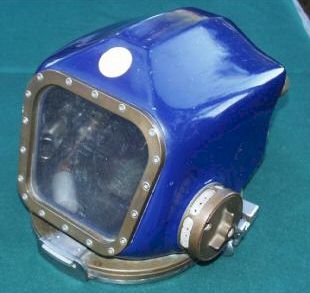
|
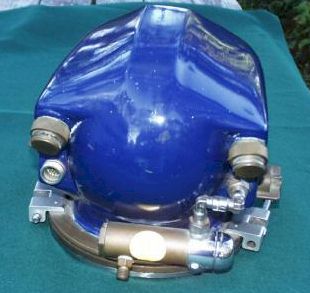
|
|
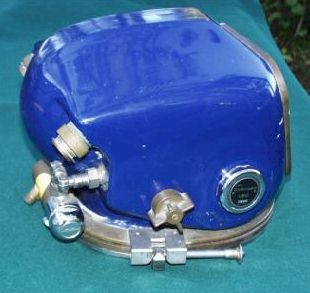
|

|
|
This helmet
was made in Lynn Haven, Florida and was a prototype helmet for the US Navy
but the Navy went on to use the Mk12 made by Morse Diving instead. Notice
the similarities between this helmet and the Mk 12. Also notice the
regulator on the back and what looks like two gas connections mounted on
both sides of the back. It has a chin button inside with a lot of other
plumbing installed as well as the comms. It was intended for use with the
neck ring and a neckdam seal. Photo courtesy: Seahawk Company. |
# 2
|
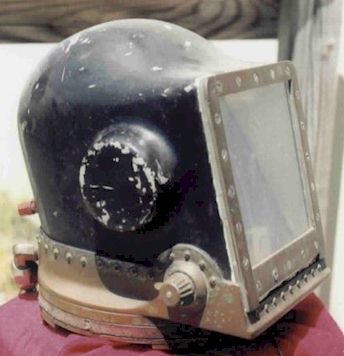
|
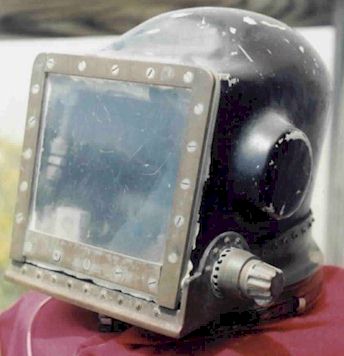
|
|
This
attached photo was taken at the Man In The Sea Museum in Panama City,
Florida USA. This is a rare example of George Swindell's earliest
free-flow (open circuit) style dive hat from the middle 1960s. This type
of hat latter evolved into the Advanced 2000 series, also called the
Swindell Hat, Beckman Helmet and even a Beckman-Swindell. The shell was of
hand-laid fiberglass and the metal parts were of machined brass. You can
note that the shell dome is form fitting (like the human head); whereas
latter Swindell hats were more vertical in the back of the shell. The hat
is very much like latter Swindell hats, that is, it is slightly positive
buoyant, it has an interrupted screw thread neck dam, a chin-button style
exhaust and a jocking harness to hold the hat down on the head. George
Swindell had some fiberglass delamination problems with these early hats
and I always found them a bit uncomfortable to work in. I think this
helmet was donated to the museum by the US Navy Experimental Diving Unit
at Panama City. The Navy liked the Swindell hat as it could fit about any
size head. One needs to take only a cursory look at the US Navy SSDS
Mark-12 helmet to see that it was influenced by the Swindell hat. |
# 3
|
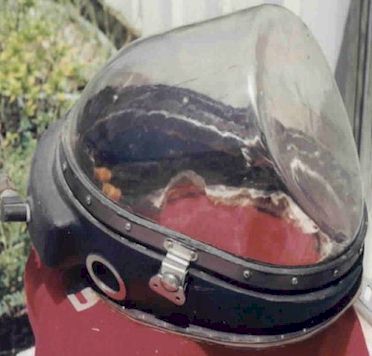
|
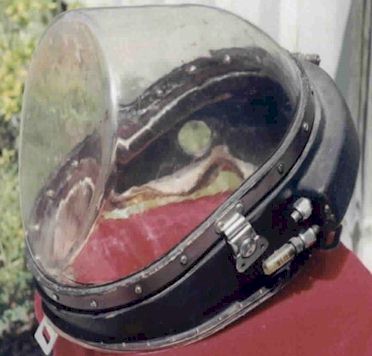
|
|
This helmet
was donated to the Man In The Sea Museum by the US Navy Experimental
Diving Unit at Panama City Florida. I do not know what the helmet
was called, but it was built in the late 1960s or early 1970s. It has a
fiberglass neck ring that attached directly to a dry suit and connections
for a jocking harness to hold the hat down on the head. The transparent
helmet part is cast from polycarbonate Lexan plastic. I know it is Lexan
as the transparent
shell has bubbles and waves in the plastic. It is very hard to heat cast
Lexan (as the Navy must have found out), because when you get it hot
enough to mold it
will bubble up. This hat is an interesting but failed idea. |
|
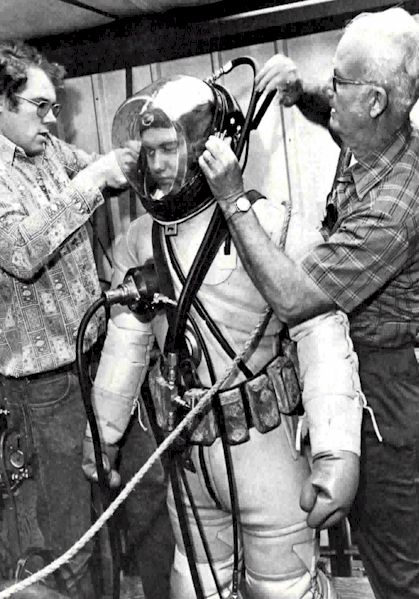 |
|
# 3 about to go down.
Official US Navy photo |
# 4
|
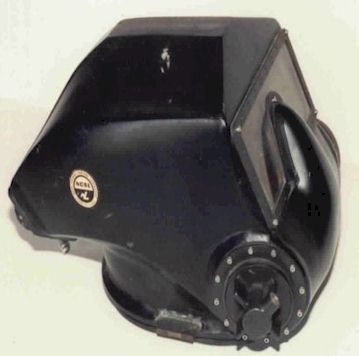
|
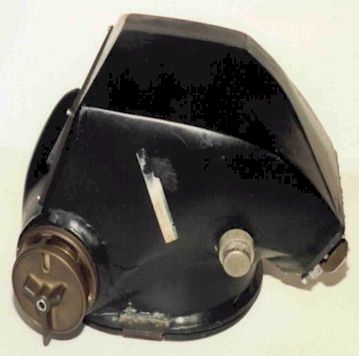
|
|
No, this
helmet is not proof that Darth Vader served in the US Navy in the 1960s.
It is an experimental diving helmet made for the Naval Coastal Systems
Laboratory (Experimental Diving Unit) at Panama City, Florida. It was
donated to the Man In The Sea Museum. If you look carefully it uses many
of the same
brass fittings that the latter Navy SSDS Mark-12 helmet used. It also is
designed to be used with a mixed-gas recirculator backpack. The fittings
on the back
of the hat are for flex hoses to connect to the back pack. the helmet
shell is fiberglass. I think this is the ugliest helmet I have ever laid
eyes on. |
# 5
|
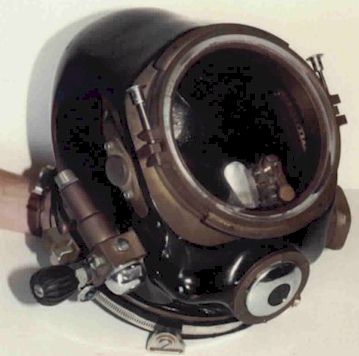
|
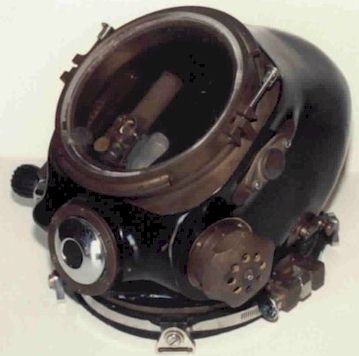
|
|
This is
another experimental diving helmet from the EDU. I think it was built and
tested in the 1970s. It is an interesting configuration, but it is also
the second ugliest helmet I have ever seen. The shell is fiberglass and
the parts are of machined brass. The hat is a demand style helmet so it is
close fitting and has a demand regulator. I do not know who built the hat
for the EDU, perhaps Morse. If you look carelfully at the photo you can
see that it too has
fittings that share features with the latter SSDS Mark-12 Navy helmet. So
the Navy must have borrowed the features from this, and other helmets that
it
liked, and put them in the SSDS Mk-12. The front facepiece port comes off
and is held on with moveable pins just like the neck dam of the SSDS
Mk-12. The nose clearing device inside the hat is machined from brass, and
the hat has a side block air intake assembly not unlike that style seen in
latter Kirby-Morgan demand type hats. |
# 6
|
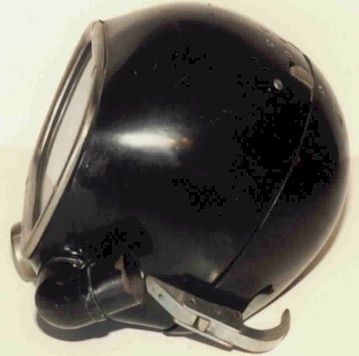
|
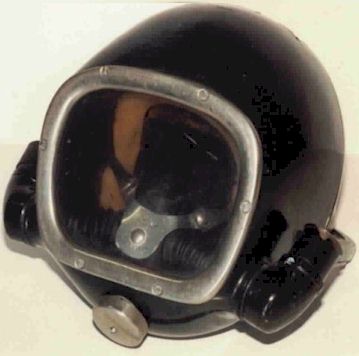
|
|
This is the
KMCSH-4. It was an early semi-closed mixed gas experimental hat built for
the EDU by the Kirby Morgan company in the middle 1960s. The
Westinghouse Oceanic Division designed the experimental backpack
helium-oxygen deep diving recirculator for the rig. Most people know
Westinghouse as the builder of kitchen appliances, but in the 1960s and
70s they built experimental life support systems for underwater and outer
space. Oddly enough they also built a few experimental stainless steel
diving helmets with neck dams. I don't have a picture of any of the
Westinghouse hats, I think only one or two were built. According to Joe's
Savoie's wife (Joyce) Westinghouse engineers got Joe to act as their
consultant (unpaid) and then they refused to give him any credit for
influencing their helmet design. Anyway back to the KMCSH-4, which is now
on display at the Man In The Sea Museum in Panama City, Florida USA. The
hat is a fiberglass clamshell design. This simply means that it sealed
around the diver's face and the helmet dome held the full face mask tight
to the diver's head. Inside it is equipped with an oral-nasal mask. The
side connections are for the hoses to the mixed gas recirculator. This hat
was not very successful. |
# 7
|
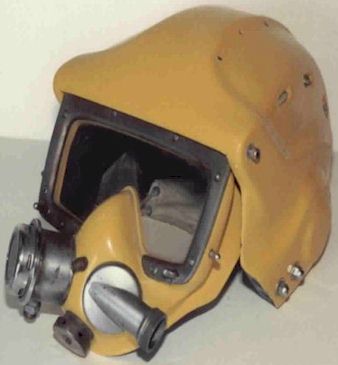
|
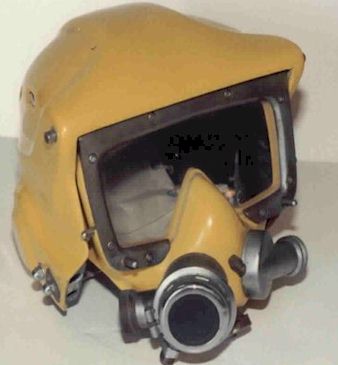
|
|
This is the
KMCSH-6. It was the final version of Kirby-Morgan's clamshell helmets. It
was built for the EDU and the SeaLab Program in the middle 1960s.
None of the Clamshell designs worked very well so they were abandoned. It
is fiberglass with a hinged head protector. The mask was built primarily
for a
mixed-gas recirculator, but you can see in it features that were latter
employed in the Kirby-Morgan Band Masks. |
# 8
|
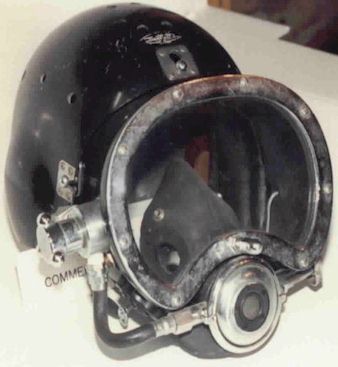
|
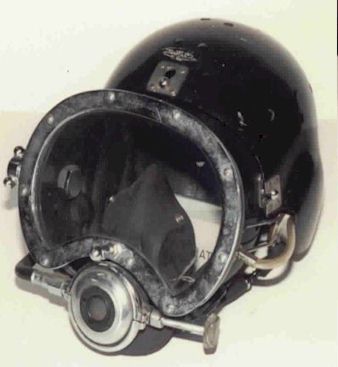
|
|
This mask is
on display at the Man In The Sea Museum. Some people claim this is the
Kirby-Morgan MM-3, and it may be. Others say it is an early General
Aquadyne rigid frame full-face mask (it is not a band mask). It has many
of the features of the early General Aquadyne masks. The mask has a
fiberglass frame with a sponge rubber face seal. The demand regulator
looks to be the ScubaPro model, like GA used. It is equipped with an
oral-nasal mask with microphone and the frame is fitted with ear speakers,
again as used by GA. The helmet dome is a padded head protector. I
dove these masks many years and found them to work well. occasionally one
still sees a General Aquadyne mask around the job site. |
# 9
|

|
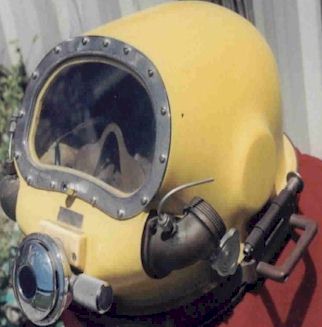
|
|
This is an
experimental diving hat built for the EDU by Morse Diving Equipment co. I
don't know the exact date of manufacture, but I suspect the 1970s or
early 80s. It is on display at the Man In The Sea Museum. The influence of
the early Kirby-Morgan helmets is obvious. This hat, which is designated
PN:
608-5168070, and SN: ADI or AD1, has a KMB superflow regulator
attached to dual hoses intended for a backpack mixed gas recirculator. The
shell is fiberglass with machined brass fittings. |
|
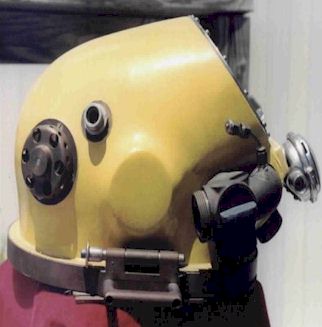
|
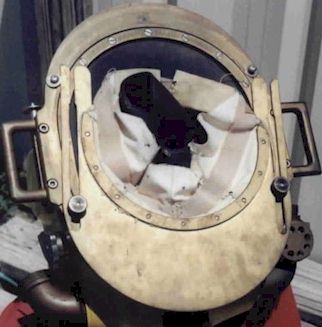
|
|
This is
another view of the experimental Morse demand hat. You can see that the
neck dam is held in place by a couple of cams with brass handles, and the
helmet is secured to the diver's head by a unique, adjustable brass slide
retainer that was obviously influenced by the Kirby-Morgan toilet seat
(retainer).
The cams are kept from coming unattached to the neck dam by pins not
unlike those on the SSDS Mk-12 neck dam. An interesting feature inside the
hat is that the head pad can be adjusted by an external handle on the port
side of the hat; this feature is a copy of the General Aquadyne DMC-7 head
pad securing
system, an excellent innovation. |
# 10
|
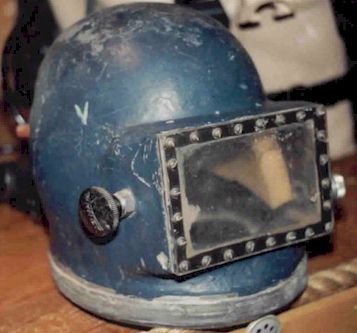
|
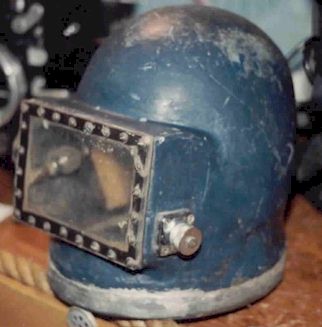
|
|
This is a
homemade free-flow style diving helmet on display at the Man In The Sea
Museum. I do not know who gave it to the museum or who made it. It has a
crude, hand laid fiberglass shell with a thick lead ring at the bottom
that secures a permanently attached neoprene neck dam. The shell is padded
inside and
also has some lead in it. The intake valve is a commercial off-the-shelf,
stainless steel Whitey needle valve. The outlet valve is an adjustable
DESCO
exhaust valve (from a DESCO pot). The faceport must have been cut from a
sheet of 6 mm thick Lexan. The hat was held on the diver's head by a jock
harness. In the early days of commercial oil patch diving in the Gulf many
divers simply could not afford, or could not find a neck dam style hat, so
they made their own. This lead to some rather strange innovation. I
knew one diver who cut out the bottom of a pressure cooker and put on a
fiberglass top and faceport. He then cut out the center of the lid and
permanently attached a ring of lead and bolted on a rubber neck seal. Once
he attached some fittings it worked pretty well (I dove it), but it was
not the type of rig I would recommend be used by amateurs. PS, don't try
this at home. |
# 11
|
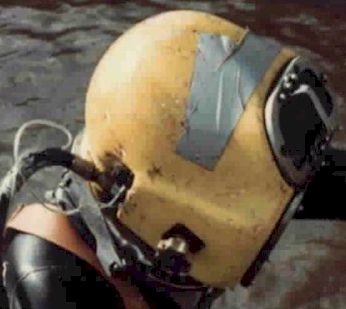
|
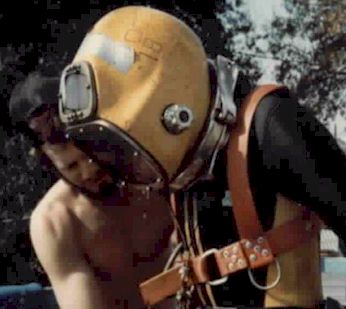
|
|
This is me
while I was in dive school at the Ocean Corporation at Houston, Texas. I
have been told that this mystery helmet is a version of the Rat Hat, but
it seems to have none of the features of the earlier Rat Hat. This
free-flow hat belonged to the Ocean Corp. and we used it in the burning
tank (underwater welding and cutting). The shell is/was fiberglass with
chrome plated brass fittings. It had good balance and dove well. The neck
dam had a couple of cam handles and the neck ring sealed on an O-ring. It
used a jock harness to keep the hat down on the diver's head. Can anyone
out there identify this hat? |
# 12
|
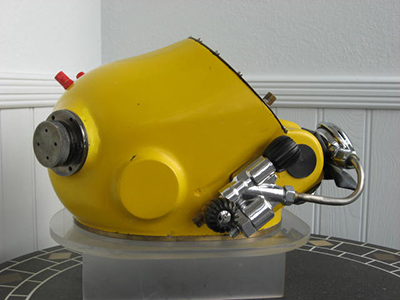 |
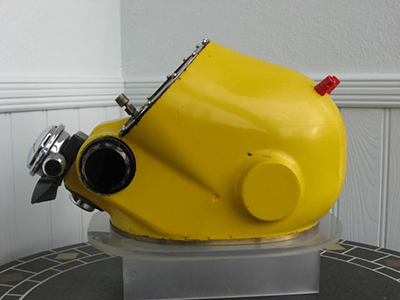 |
|
This is
another experimental helmet built for the Experimental Diving Unit by
Morse Diving Equipment Company. It dates to the mid 1970s.
The regulator is very close in design to the US Divers valve as is the
side block valve assembly.
|
|
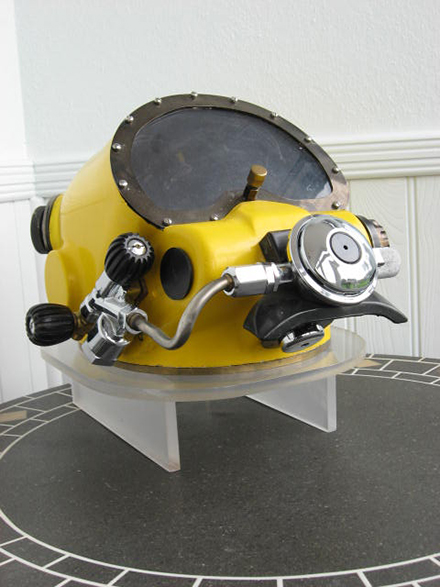 |
|
The shell is
made of yellow fiberglass and the metal parts are chrome brass and
bronze. |
All text and
pictures in this section, except #1 and #12 are by courtesy of Gary L. Harris
- Last update: 1st February
2013




























